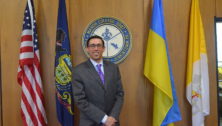Art Therapy: A Catalyst for Healing through Art

As part of our innovative trauma-informed approach to transforming lives and communities through education, coaching and counseling, The Lincoln Center for Family and Youth (TLC) has embraced Art Therapy as an alternative method for helping clients process trauma.

Since May 2018, TLC’s Victims Services program, funded by the Pennsylvania Commission on Crime and Delinquency (PCCD), has expanded services to include three trauma-informed, certified Art Therapists.
Our mobile art therapy staff have served many individuals and families in the Greater Philadelphia area by providing a safe space to process (verbally and non-verbally) painful experiences that impede our clients’ ability to reach their full potential.
Humans have a long history of using the arts to connect and understand each other’s thoughts and feelings.
For that reason, Art Therapy is a very innovative yet very intuitive approach.
Consider peoples’ early attempts to communicate via art as seen on ancient cave walls or a baby’s ability to connect with others by babbling, dancing or building without the aid of verbal language.
Humans begin to create, build, and explore without having to be taught because we are inherently expressive beings, curious about our world and wanting to engage with it.
Children pick up crayons as soon as they are able to form a grasp and begin putting color and lines to paper without having to be taught art. These are all unconscious forms of expression devoid of verbal language.
Art Therapy is also relevant and effective when considering the science of how our brains function. Most language skills are developed, executed and processed through the frontal lobe of the brain; however, our brains store impactful and poignant memories (good and bad) in our limbic system.
The limbic system, sometimes referred to as the “emotional brain,” is responsible for regulating our emotions and processing our memories in addition to our “flight, fight, or freeze” response.
In the limbic system, our experiences are stored nonverbally through our feelings and senses, not through logical reasoning or executive functioning.
Considering our brain stores impactful information in a non-logical manner, processing traumatic events through talk therapy can seem antithetical for some individuals. This could be the very reason why so many people have historically “hit a wall” with talk therapy, which can be frustrating to the client and the clinician.
Recognition of this pattern was the impetus for TLC to pursue an alternative therapy approach to help our clients process unresolved trauma lodged in the non-verbal centers of the brain.
Most of the victims of crime that TLC serves are diagnosed or are suspected of having Post Traumatic Stress Disorder (PTSD).
Since most PTSD recovery involves reconnecting the client to their often dissociated mind and body, art therapy helps clients find some grounding to shine light on those parts of themselves and memories that are difficult to verbalize and understand.
“As an art therapist, my main objective is to create a space for my client to feel safe enough to be heard and seen,” Yael Tsoran, the newest addition to the TLC art therapy team, said. “Art can speak volumes about a person’s traumatic experience and a trained art therapist can help guide clients to heal through their art. They recreate their reality, which is extremely powerful.”
Art therapists utilize their education and training to catalyze a discussion that steps outside traditional psychotherapy. Through the process of art making, whether it be traditional drawing and painting, reflective writing, collage, sculpture and other mediums available, the art therapist supports their client in creating a visual story, dialogue or graphic timeline of their trauma.
In addition, these processes and directives are used to support self-regulation, provide insight, and reduce stress responses that result from trauma.
The TLC team is constantly striving to educate ourselves on the most effective techniques to create space for true transformation to occur in our staff and our clients. The inception of the Art Therapy service we provide is just one of the ways that we are leveraging unconventional therapeutic methods to empower individuals and families throughout our community with the will and skill to reach their full potential.
Stay Connected, Stay Informed
Subscribe for great stories in your community!
"*" indicates required fields









![95000-1023_ACJ_BannerAd[1]](https://montco.today/wp-content/uploads/sites/2/2023/03/95000-1023_ACJ_BannerAd1.jpg)






















![ForAll_Digital-Ad_Dan_1940x300[59]](https://montco.today/wp-content/uploads/sites/2/2022/06/ForAll_Digital-Ad_Dan_1940x30059.jpg)









